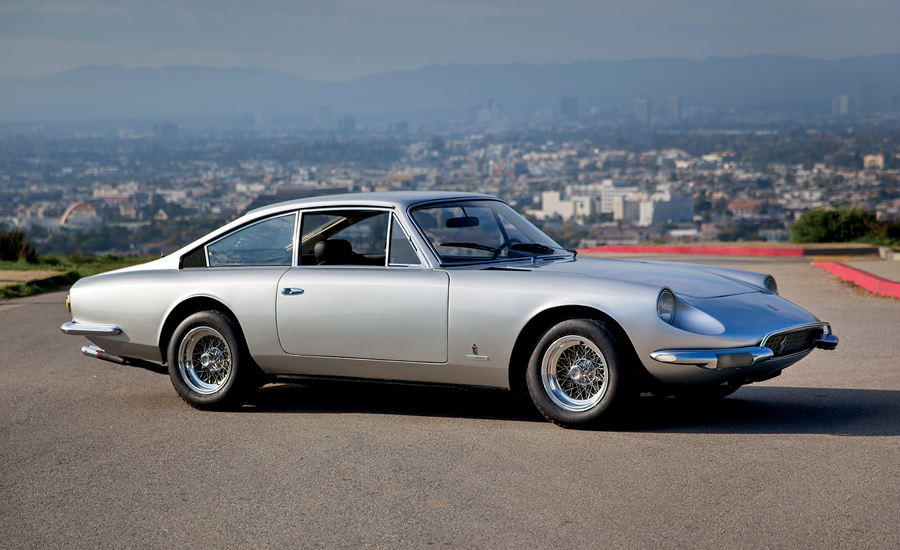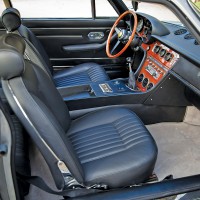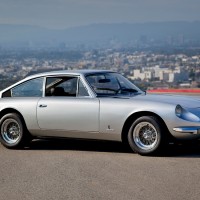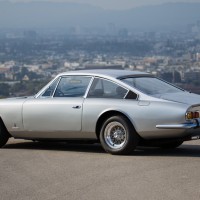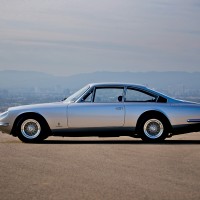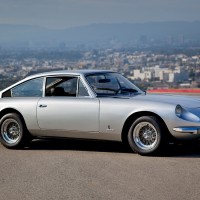SCM Analysis
Detailing
| Vehicle: | 1970 Ferrari 365 GT 2 2 |
| Years Produced: | 1967–71 |
| Number Produced: | 809 |
| Original List Price: | $18,900 |
| SCM Valuation: | $150,000–$350,000 |
| Tune Up Cost: | $4,000 |
| Distributor Caps: | $450 (two required) |
| Chassis Number Location: | On frame above right front spring mount |
| Engine Number Location: | Stamped on a boss below head on rear right side of the block |
| Club Info: | Ferrari Club of America |
| Website: | http://FerrariClubofAmerica.org |
| Alternatives: | 1968 Lamborghini 400GT 2 2, 1970 Aston Martin DBS V8, 1970 Jaguar XKE 2 2, 1970 Mercedes-Benz 300SEL 6.3 |
| Investment Grade: | C |
This car, Lot 9, sold for $280,500, including buyer’s premium, at Gooding & Company’s Amelia Island, FL, auction on March 13, 2015.
The writer at Road & Track who christened the Ferrari 365 GT 2+2 the “Queen Mother of Ferraris” surely had no idea that the model would forever be known by that name.
Mention 365 2+2 to the casual Ferrari enthusiast and their eyes turn blank as they inventory the nine or so different 365 models searching for a match. Replace 365 2+2 with Queen Mother and there’s an immediate recognition of the model. The name may be slightly condescending, but it aptly describes the Ferrari 365 GT 2+2.
The image of a Queen Mother is one of a slightly plump, matronly woman. The lady is dignified, mature, and of an elevated social position. The 365 GT 2+2 was aimed at mature clients who appreciated a car that was elegant rather than flashy. Its physical size was the largest of any Ferrari up to that date, and it was more than adequate for family transportation. There was no pretense of the 365 GT 2+2 being a sports car; she was a grand touring machine of the highest order. While her size was imposing, she was nimble and performed admirably.
You have to drive a Queen Mother to really appreciate the car. The engine is simply wonderful in its performance and sound. The two-cam configuration is instantly responsive to throttle input. It revs effortlessly, building impressive torque from even the lower ranges.
The transmission is a front-mounted 5-speed rather than the transaxle that contemporary Ferrari two-passenger cars used. The gear changes are as smooth and precise as any car that you will encounter. Power steering was standard on the model, and while a bit light, does the job well.
Lots of rough cars out there
Putting a value on a 365 2+2 is about like herding cats. Prices are all over the board, and it’s hard to get a real feel of the market. Currently there are cars advertised from $167,000 to $459,000.
In the past year, auctions prices have varied from about $160,000 to $374,000. What gives? The problem is that many 365 2+2s have had a rough life. They have often been subjected to high use and deferred maintenance. While the first owner may have been able and willing to properly maintain the car, subsequent owners often bought 365 2+2s because that was all that they could afford — and they were in denial on potential ownership costs.
It is no less expensive to perform routine service on a 365 2+2 than on a Daytona. The 2+2 car’s higher use meant they required more mechanical service than a Daytona, but, unfortunately, the 2+2 owner was often less willing and able to pay for the maintenance. These superb cars were often patched up rather than properly repaired, and the sins are still there today. Correspondingly, the higher use also meant accelerated cosmetic wear, and again, the repairs were often patches rather than restorations.
A full restoration doesn’t pencil out
“More” is the catchword of restoring a 2+2 Ferrari. There’s more chrome, more leather, more metal and more work needed. Of course, that means more cost at the restoration shop. Conversely, the value of a 2+2 is significantly less than a two-passenger Ferrari.
It is not economically feasible to do a high-end restoration on a 365 2+2. What you’ll find on the market are a few well-kept original cars and some refurbished cars of varying quality.
Chassis 13069 fits in the latter category. The fact that it has lived in an excellent climate makes it a worthy candidate for consideration. It also had long-term ownership, which is a plus. In terms of condition, it’s been caught in the 2+2 trap of not being valuable enough for a thorough restoration. The owner estimates he’s spent around $100,000 on maintenance, but that has been over many years.
There has never been a cohesive restoration and it shows. The interior has recently been refurbished and looks great — the rest of the car not so much so. The paint has been updated and is not great. There are several flaws indicative of the value paint jobs that are the norm for the model. The engine compartment looks good — until you look closely, and then its age shows. Keep looking and you’ll find more problems.
13069 falls into the “average” category, and the auction result was appropriate. RM Sotheby’s just sold a similar car at their Villa Erba auction for roughly the same price. Gooding sold a much better car for $374,000 at Scottsdale earlier this year.
A 365 2+2 can be a good choice for a first venture into the vintage Ferrari world. It is unrealistic to expect one to look like the freshly restored 275 GTB you saw at the concours, but there are some nice examples available. There are also some real dogs, so it is imperative to have a professional inspection on any car that you might be considering.
A good example will be a pleasure to own. A bad example will eat money like a yacht and bring you no joy. ♦
(Introductory description courtesy of Gooding & Company.)
This car, Lot 9, sold for $280,500, including buyer’s premium, at Gooding & Company’s Amelia Island, FL, auction on March 13, 2015.
The writer at Road & Track who christened the Ferrari 365 GT 2+2 the “Queen Mother of Ferraris” surely had no idea that the model would forever be known by that name.
Mention 365 2+2 to the casual Ferrari enthusiast and their eyes turn blank as they inventory the nine or so different 365 models searching for a match. Replace 365 2+2 with Queen Mother and there’s an immediate recognition of the model. The name may be slightly condescending, but it aptly describes the Ferrari 365 GT 2+2.
The image of a Queen Mother is one of a slightly plump, matronly woman. The lady is dignified, mature, and of an elevated social position. The 365 GT 2+2 was aimed at mature clients who appreciated a car that was elegant rather than flashy. Its physical size was the largest of any Ferrari up to that date, and it was more than adequate for family transportation. There was no pretense of the 365 GT 2+2 being a sports car; she was a grand touring machine of the highest order. While her size was imposing, she was nimble and performed admirably.
You have to drive a Queen Mother to really appreciate the car. The engine is simply wonderful in its performance and sound. The two-cam configuration is instantly responsive to throttle input. It revs effortlessly, building impressive torque from even the lower ranges.
The transmission is a front-mounted 5-speed rather than the transaxle that contemporary Ferrari two-passenger cars used. The gear changes are as smooth and precise as any car that you will encounter. Power steering was standard on the model, and while a bit light, does the job well.
Lots of rough cars out there
Putting a value on a 365 2+2 is about like herding cats. Prices are all over the board, and it’s hard to get a real feel of the market. Currently there are cars advertised from $167,000 to $459,000.
In the past year, auctions prices have varied from about $160,000 to $374,000. What gives? The problem is that many 365 2+2s have had a rough life. They have often been subjected to high use and deferred maintenance. While the first owner may have been able and willing to properly maintain the car, subsequent owners often bought 365 2+2s because that was all that they could afford — and they were in denial on potential ownership costs.
It is no less expensive to perform routine service on a 365 2+2 than on a Daytona. The 2+2 car’s higher use meant they required more mechanical service than a Daytona, but, unfortunately, the 2+2 owner was often less willing and able to pay for the maintenance. These superb cars were often patched up rather than properly repaired, and the sins are still there today. Correspondingly, the higher use also meant accelerated cosmetic wear, and again, the repairs were often patches rather than restorations.
A full restoration doesn’t pencil out
“More” is the catchword of restoring a 2+2 Ferrari. There’s more chrome, more leather, more metal and more work needed. Of course, that means more cost at the restoration shop. Conversely, the value of a 2+2 is significantly less than a two-passenger Ferrari.
It is not economically feasible to do a high-end restoration on a 365 2+2. What you’ll find on the market are a few well-kept original cars and some refurbished cars of varying quality.
Chassis 13069 fits in the latter category. The fact that it has lived in an excellent climate makes it a worthy candidate for consideration. It also had long-term ownership, which is a plus. In terms of condition, it’s been caught in the 2+2 trap of not being valuable enough for a thorough restoration. The owner estimates he’s spent around $100,000 on maintenance, but that has been over many years.
There has never been a cohesive restoration and it shows. The interior has recently been refurbished and looks great — the rest of the car not so much so. The paint has been updated and is not great. There are several flaws indicative of the value paint jobs that are the norm for the model. The engine compartment looks good — until you look closely, and then its age shows. Keep looking and you’ll find more problems.
13069 falls into the “average” category, and the auction result was appropriate. RM Sotheby’s just sold a similar car at their Villa Erba auction for roughly the same price. Gooding sold a much better car for $374,000 at Scottsdale earlier this year.
A 365 2+2 can be a good choice for a first venture into the vintage Ferrari world. It is unrealistic to expect one to look like the freshly restored 275 GTB you saw at the concours, but there are some nice examples available. There are also some real dogs, so it is imperative to have a professional inspection on any car that you might be considering.
A good example will be a pleasure to own. A bad example will eat money like a yacht and bring you no joy. ♦
(Introductory description courtesy of Gooding & Company.)
This car, Lot 9, sold for $280,500, including buyer’s premium, at Gooding & Company’s Amelia Island, FL, auction on March 13, 2015.
The writer at Road & Track who christened the Ferrari 365 GT 2+2 the “Queen Mother of Ferraris” surely had no idea that the model would forever be known by that name.
Mention 365 2+2 to the casual Ferrari enthusiast and their eyes turn blank as they inventory the nine or so different 365 models searching for a match. Replace 365 2+2 with Queen Mother and there’s an immediate recognition of the model. The name may be slightly condescending, but it aptly describes the Ferrari 365 GT 2+2.
The image of a Queen Mother is one of a slightly plump, matronly woman. The lady is dignified, mature, and of an elevated social position. The 365 GT 2+2 was aimed at mature clients who appreciated a car that was elegant rather than flashy. Its physical size was the largest of any Ferrari up to that date, and it was more than adequate for family transportation. There was no pretense of the 365 GT 2+2 being a sports car; she was a grand touring machine of the highest order. While her size was imposing, she was nimble and performed admirably.
You have to drive a Queen Mother to really appreciate the car. The engine is simply wonderful in its performance and sound. The two-cam configuration is instantly responsive to throttle input. It revs effortlessly, building impressive torque from even the lower ranges.
The transmission is a front-mounted 5-speed rather than the transaxle that contemporary Ferrari two-passenger cars used. The gear changes are as smooth and precise as any car that you will encounter. Power steering was standard on the model, and while a bit light, does the job well.
Lots of rough cars out there
Putting a value on a 365 2+2 is about like herding cats. Prices are all over the board, and it’s hard to get a real feel of the market. Currently there are cars advertised from $167,000 to $459,000.
In the past year, auctions prices have varied from about $160,000 to $374,000. What gives? The problem is that many 365 2+2s have had a rough life. They have often been subjected to high use and deferred maintenance. While the first owner may have been able and willing to properly maintain the car, subsequent owners often bought 365 2+2s because that was all that they could afford — and they were in denial on potential ownership costs.
It is no less expensive to perform routine service on a 365 2+2 than on a Daytona. The 2+2 car’s higher use meant they required more mechanical service than a Daytona, but, unfortunately, the 2+2 owner was often less willing and able to pay for the maintenance. These superb cars were often patched up rather than properly repaired, and the sins are still there today. Correspondingly, the higher use also meant accelerated cosmetic wear, and again, the repairs were often patches rather than restorations.
A full restoration doesn’t pencil out
“More” is the catchword of restoring a 2+2 Ferrari. There’s more chrome, more leather, more metal and more work needed. Of course, that means more cost at the restoration shop. Conversely, the value of a 2+2 is significantly less than a two-passenger Ferrari.
It is not economically feasible to do a high-end restoration on a 365 2+2. What you’ll find on the market are a few well-kept original cars and some refurbished cars of varying quality.
Chassis 13069 fits in the latter category. The fact that it has lived in an excellent climate makes it a worthy candidate for consideration. It also had long-term ownership, which is a plus. In terms of condition, it’s been caught in the 2+2 trap of not being valuable enough for a thorough restoration. The owner estimates he’s spent around $100,000 on maintenance, but that has been over many years.
There has never been a cohesive restoration and it shows. The interior has recently been refurbished and looks great — the rest of the car not so much so. The paint has been updated and is not great. There are several flaws indicative of the value paint jobs that are the norm for the model. The engine compartment looks good — until you look closely, and then its age shows. Keep looking and you’ll find more problems.
13069 falls into the “average” category, and the auction result was appropriate. RM Sotheby’s just sold a similar car at their Villa Erba auction for roughly the same price. Gooding sold a much better car for $374,000 at Scottsdale earlier this year.
A 365 2+2 can be a good choice for a first venture into the vintage Ferrari world. It is unrealistic to expect one to look like the freshly restored 275 GTB you saw at the concours, but there are some nice examples available. There are also some real dogs, so it is imperative to have a professional inspection on any car that you might be considering.
A good example will be a pleasure to own. A bad example will eat money like a yacht and bring you no joy. ♦
(Introductory description courtesy of Gooding & Company.)
